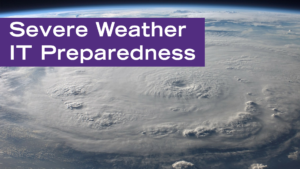Severe Weather IT Preparedness
Ryan Real,
Public Information Coordinator
September 12, 2018
 Severe weather can strike at any time. With that in mind, here are some tips to follow that can help protect you and your technology. Also, be sure to follow instructions at ready.gov for general disaster preparedness.
Severe weather can strike at any time. With that in mind, here are some tips to follow that can help protect you and your technology. Also, be sure to follow instructions at ready.gov for general disaster preparedness.
Update your my.Clemson information
Be sure that your information is up-to-date in my.Clemson, including your CU Alert Number and your emergency contact information. To view and modify this information, visit my.clemson.edu or use the my.Clemson app, click on your photo, and click “My Profile.”
To get CU Safe Alerts on your phone, follow these instructions.
Familiarize yourself with Clemson University’s safety information
Clemson.edu/cusafety will update with safety information throughout Hurricane Irma (as well as @CUSafety on Twitter), including detailed messages and weather advisories. The page also includes an Emergency Preparedness section, featuring “Severe Weather” and “Campus Emergency Communications” tab.
Backup your data
It’s always a good idea to consistently back up your data. As a member of the Clemson community, you have free cloud storage with Google Drive, Box and OneDrive. All of these should still be accessible in the event of severe weather at Clemson. Make sure to keep copies of frequently used documents in addition to regular backups.
What happens if Clemson applications are down?
The CCIT status page at status.ccit.clemson.edu is hosted off-site and should remain accessible, as should the CCIT website at ccit.clemson.edu. We will continue to post updates to university systems on the status page with information regarding possible service interruptions, as well as posting updates to the official CCIT Twitter account at @ClemsonIT.
Other general preparedness tips:
- Extend the battery life of your devices by:
- Turn off Wi Fi when not in use.
- Turn off Bluetooth.
- Dim your screen.
- Turn off push notifications from unnecessary apps.
- Keep wireless devices charged at all times, and keep a back-up battery on hand. Consider car or solar chargers for your devices as well.
- Keep your devices dry. If you don’t have a waterproof case, Ziploc and similar bags will work well also.
- Don’t turn your tablet or phone on and off to preserve battery life. Your device will use more energy powering back up than in sleep/rest mode.
- After the storm and the power is back on, wait until there are no blackouts or surges before plugging your equipment back in. Be sure that critical equipment has an Uninterruptible Power Supply (UPS) attached.
- After natural disasters, cybercriminals often try to take advantage of those impacted and trying to provide relief efforts. Whether through email or social media, protect yourself against scams and cyberattacks using a few simple tips:
- Pay attention to the URL of the websites you visit. Malicious websites may look identical to a legitimate site, but the URL may use a variation in spelling or a different domain (for example: .com vs. .net).
- Be suspicious of unsolicited phone calls, visits, or email messages.
- Do not reveal personal or financial information in email, and do not respond to email solicitations for this information.
- Do not follow unsolicited web links in email messages or open any attachments.
Notices
Outage of Multiple Clemson Applications, June 26, 2024
Changes To Clemson Email Quarantine
FCC/FEMA Emergency Alert System Test on October 4, 2023
Check the status of university systems on Status Hub
Security upgrades to impact email spam retrieval beginning July 12, 2023
Campus network and TikTok — July 10, 2023
Kronos to require log-in through Duo mobile application on July 21, 2023
PeopleSoft and Banner Outage on June 11, 2023
Upcoming changes to Google Workspace
Temporary restrictions to iROAR access – Nov. 30, 2022
Welcome Back: Important IT Updates for Faculty and Staff
Welcome Back: Important IT Updates for Students
Eduroam Update – July 15, 2022
New Student Laptop Models Available for 2024-2025
 Cybersecurity
Cybersecurity
